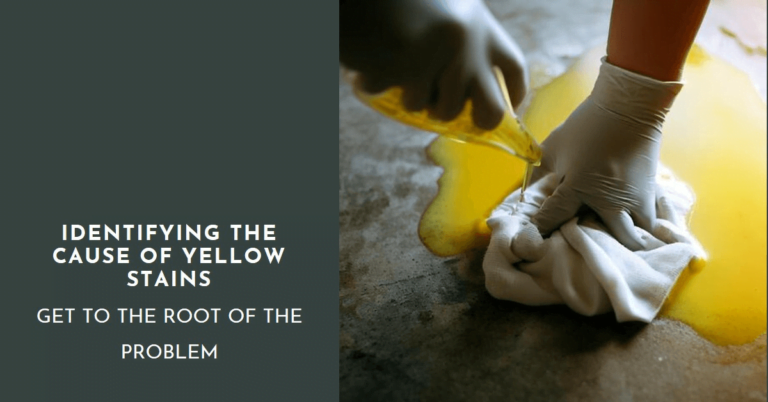How To Remove Linoleum From Concrete
If you’re renovating a space in your home, you may come across the daunting task of removing linoleum from your…
If you’re renovating a space in your home, you may come across the daunting task of removing linoleum from your concrete floor. It can be a messy and time-consuming process, but with the right tools and techniques, it’s definitely doable.
In this article, we’ll guide you through the steps to remove linoleum from concrete and have your floors looking fresh and new.
Before you start, it’s important to prepare your workspace and take safety precautions. Make sure you have the necessary tools on hand and wear protective gear such as gloves and goggles.
With the right mindset and a bit of elbow grease, you’ll be able to successfully remove the linoleum and reveal the beauty of your concrete floors.
So let’s get started!
Preparing Your Workspace and Safety Precautions
Before you start, it’s important to take the necessary safety precautions and properly prepare your workspace to ensure a smooth and safe linoleum removal process.
First, wear protective clothing such as gloves, goggles, and a mask to avoid skin irritation, eye damage, and respiratory problems. Additionally, make sure the area is well-ventilated to avoid inhaling harmful fumes. Open windows and doors or use a fan to improve air circulation.
Next, gather the necessary tools needed for the job. You’ll need a putty knife, a floor scraper, a heat gun, and a solvent.
The putty knife and floor scraper will be used to remove any adhesive residue left behind after removing the linoleum. The heat gun will help soften the adhesive and make it easier to remove, while the solvent will dissolve any remaining adhesive and make it easier to scrape off.
It’s also important to be aware of potential hazards before starting the linoleum removal process. For instance, the adhesive used to attach the linoleum to the concrete may contain asbestos, which is a toxic substance that can cause lung cancer and other respiratory problems if inhaled.
Therefore, it’s important to have the adhesive tested for asbestos before starting the removal process. If asbestos is detected, it’s best to hire a professional to remove the linoleum.
Removing the Top Layer of Linoleum
You can easily get rid of the top layer of linoleum by scoring it with a utility knife and then using a scraper to peel it off. Before starting, make sure to wear gloves and safety glasses to protect your hands and eyes. Additionally, ensure that you have all the necessary tools needed for the job, including:
- Utility knife
- Scraper
- Floor stripper
- Heat gun (optional)
Using a utility knife, score the linoleum into manageable sections, about 6 inches wide. Be careful not to cut too deeply into the concrete underneath.
Then, use a scraper to lift the scored sections of linoleum off the floor. Work in small sections at a time, repeating the process until all the top layers of linoleum are removed.
If you encounter any stubborn areas, you can try using a floor stripper or heat gun as an alternative removal method. Removing the top layer of linoleum can be a time-consuming process, but it’s an essential step in properly preparing the concrete for further removal.
It’s crucial to make sure you remove as much of the linoleum as possible to avoid any issues with the adhesive underneath. By following these steps and using the right tools, you can successfully remove the top layer of linoleum and prepare your workspace for the next phase of removal.
Softening the Adhesive
Now it’s time to make your job easier by softening the adhesive beneath the top layer of your flooring. This step is crucial in ensuring that the linoleum comes off easily and without damaging the concrete.
There are two main options for softening the adhesive: using heating techniques or chemical solvents. If you choose to use heating techniques, you can start by using a heat gun or a hair dryer to warm up the adhesive. The heat will soften the adhesive and make it easier to scrape off. Be careful not to overheat the linoleum as this may cause it to melt and make removal even more difficult.
Once you’ve heated up a section of the flooring, use a scraper to gently pry it up. Repeat this process until you’ve removed all the linoleum.
On the other hand, if you decide to use chemical solvents, you can use a product specifically designed for linoleum removal. Make sure to follow the instructions carefully, and wear protective gear such as gloves and a mask. Apply the solvent to the adhesive and let it sit for the recommended amount of time. The solvent will break down the adhesive, making it easier to scrape off.
Once the adhesive is soft, use a scraper to remove it. By softening the adhesive, you can make the task of removing linoleum from concrete much easier. Whether you choose to use heating techniques or chemical solvents, always take the necessary precautions to ensure your safety.
With patience and persistence, you’ll be able to remove the linoleum and reveal a clean concrete surface beneath.
Scraping and Sanding the Concrete Surface
Scraping and sanding the surface is a necessary step in preparing the floor for any new covering. After softening the adhesive, you can begin to remove the linoleum from the concrete surface. The adhesive will leave a residue on the floor that needs to be removed before you can install new flooring.
Scraping is the first step of the process, and it requires a lot of elbow grease. You can use a scraper tool to remove the linoleum from the surface of the concrete. Start at one end of the floor and work your way across, pulling up the linoleum as you go. If the adhesive is stubborn, you may need to use a heat gun to soften it further.
After the linoleum is removed, you will need to sand the surface of the concrete. This is an important step in concrete surface preparation. Use a floor sander or a hand-held sander to remove any remaining adhesive and to smooth out the surface.
Be sure to wear a mask to protect yourself from the dust. Once you have finished sanding, vacuum the floor to remove any remaining dust and debris.
Incorporating alternative linoleum removal methods may be helpful, but scraping and sanding the surface is the most effective way to remove linoleum from concrete. These steps will ensure that your new flooring adheres properly to the concrete surface.
With patience and a little bit of effort, you can have a smooth and clean surface ready for your new flooring.
Cleaning Up and Finishing Touches
After completing the arduous task of preparing the surface, the next step in the process involves ensuring the area is clean and ready for finishing touches.
This means cleaning up any debris left from scraping and sanding, as well as removing any remaining adhesive from the concrete surface. Once the surface is clean, it’s time to consider staining techniques or applying protective coatings.
Staining the concrete surface can provide a unique and attractive finish. There are a variety of staining techniques available, including acid stains, water-based stains, and dyes. Acid stains react with the minerals in the concrete to create a natural, marbled effect, while water-based stains and dyes provide solid color options.
Whatever technique you choose, ensure that the surface is completely dry and free of dust before applying the stain. Another option for finishing the concrete surface is to apply a protective coating. This can help to protect the surface from damage, as well as enhance its appearance.
There are a variety of coatings available, including epoxy, urethane, and acrylic sealers. Each type of coating has its own benefits and drawbacks, so it’s important to choose the right one for your specific needs. Whatever coating you choose, ensure that the surface is completely clean and dry before applying it.
Without a doubt, cleaning up and adding finishing touches to the concrete surface is a crucial step in the process of removing linoleum. By ensuring that the surface is entirely clean and dry, you can guarantee that any staining techniques or protective coatings will adhere properly.
With the right approach, you can turn the formerly unsightly concrete surface into an attractive and functional space.
Conclusion
And that’s how we successfully removed linoleum from concrete! It may have been a tedious process, but it was definitely worth it in the end.
By preparing our workspace and taking the necessary safety precautions, we were able to avoid any accidents or injuries. We then removed the top layer of linoleum, softened the adhesive, and scraped and sanded the concrete surface until it was smooth and ready for a new finish.
Remember, if you ever find yourself in a situation where you need to remove linoleum from concrete, take your time and be patient. It may not be the easiest task, but with the right tools and techniques, it can be done. Plus, by doing it yourself, you’ll not only save money, but you’ll also gain a sense of satisfaction and accomplishment.
So go ahead, roll up your sleeves and get to work!


